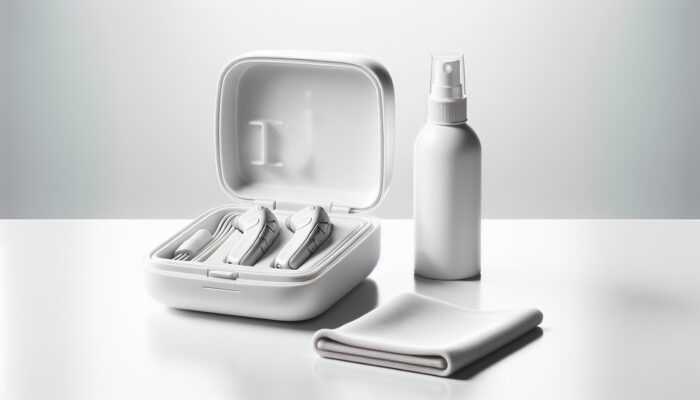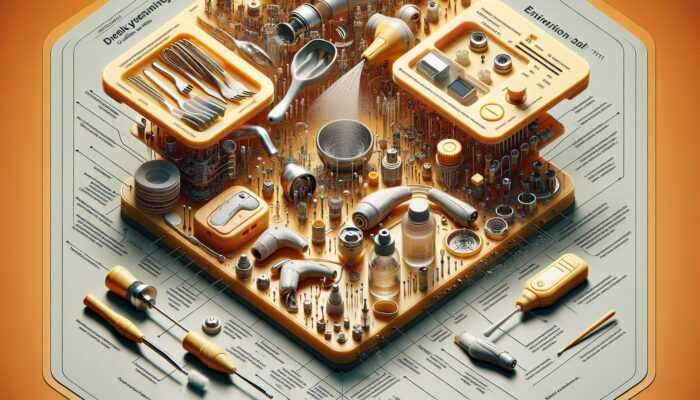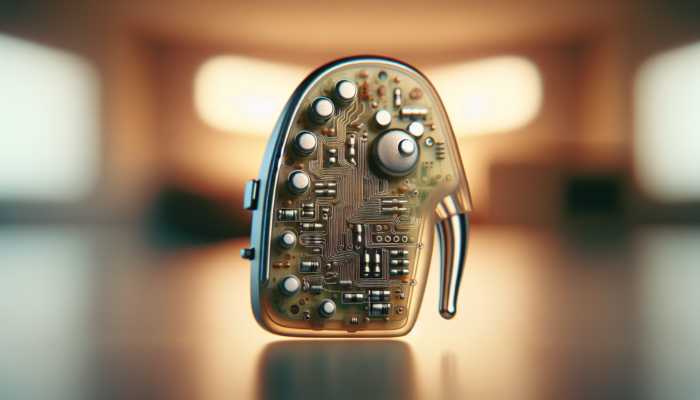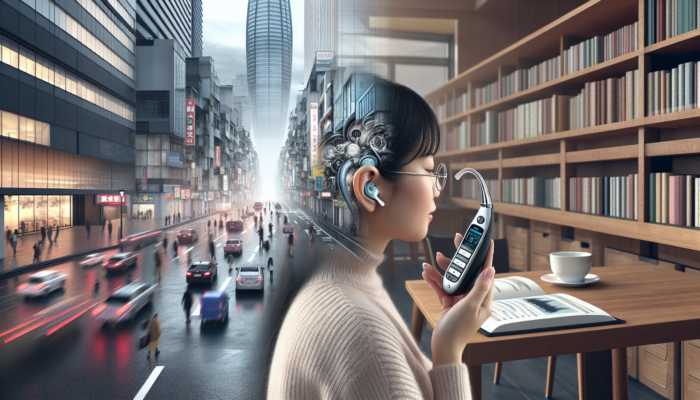Last Updated on 02/08/2025 by Admin
Discover the Transformative Advantages of In-the-Ear Hearing Aids: Are They the Ideal Choice for You?
In today’s fast-paced and interconnected society, the significance of effective communication is paramount. The introduction of <a href=”https://www.earwaxremoval.net/hearing-aids-for-tinnitus-relief-your-essential-guide/”>in-the-ear hearing aids</a> has dramatically transformed how those with hearing difficulties interact with their surroundings. These state-of-the-art devices offer a multitude of advantages that go well beyond simple sound amplification. Let’s explore the extraordinary benefits that position in-the-ear hearing aids as a highly appealing choice for many individuals seeking to enhance their auditory experiences.
Experience Exceptional Sound Quality with In-the-Ear Hearing Aids
One of the standout benefits of in-the-ear hearing aids is their remarkable ability to provide exceptional sound quality. Nestled snugly within the ear canal, these devices are optimally situated to convey sound waves directly to the eardrum. This close proximity drastically reduces the distortion that is often found in larger hearing aids, resulting in a listening experience that feels more natural and immersive. Users consistently report that the clarity of conversations and the richness of musical notes are significantly enhanced compared to conventional hearing aid models.
Moreover, the compact structure of in-the-ear hearing aids allows for the integration of advanced sound processing technologies. Features such as adaptive sound control automatically modify settings in response to environmental changes, guaranteeing optimal hearing in a variety of settings—whether enjoying a busy café in Paris or relaxing in a tranquil park in Tokyo. This level of adaptability is crucial for individuals who traverse different auditory environments throughout their day.
Finally, the enhancement in sound quality not only improves daily interactions but also enriches social experiences. Users can engage in conversations with ease, eliminating the constant struggle to interpret muffled sounds. This newfound confidence can lead to deeper connections and improved relationships, significantly enhancing overall quality of life.
Embrace the Discreet Design of In-the-Ear Hearing Aids
For numerous individuals, the visibility of hearing aids poses a considerable concern. The discreet design of in-the-ear hearing aids directly addresses this issue. With their snug fit within the ear canal, these devices often remain virtually undetectable to others. This subtlety is especially attractive to younger users and professionals who may feel self-conscious about wearing more conspicuous hearing aids.
Additionally, the aesthetic appeal of in-the-ear models is complemented by a variety of customizable options. Users can select colors and designs that blend seamlessly with their skin tone or reflect their personal style, further enhancing the discreet nature of these devices. The end result is a hearing solution that feels less like a medical apparatus and more like a personal accessory, empowering users to wear their hearing aids with pride and confidence.
Furthermore, the psychological advantages of using discreet hearing aids are profound. The reduced visibility can significantly diminish the stigma often associated with hearing loss, encouraging individuals to seek the help they need without fear of judgment. This shift in perception contributes to improved mental well-being, fostering a more positive relationship with one’s hearing health and overall self-image.
Enjoy a Custom Fit for Optimal Comfort and Performance
Every individual’s ear is uniquely shaped, and this is where the true magic of in-the-ear hearing aids comes into play. These devices are meticulously custom-made to fit the specific contours of a person’s ear. This personalized approach not only ensures a secure and comfortable fit but also maximizes auditory performance, allowing users to hear more clearly and comfortably.
The fitting process begins with a comprehensive audiological evaluation, followed by creating a precise ear mold impression. Skilled audiologists use this impression to fabricate hearing aids that conform perfectly to the user’s ear canal. This attention to detail minimizes the risk of feedback and enhances sound isolation, enabling users to focus on the sounds that matter most in their lives.
In addition to performance, a custom fit greatly enhances user comfort. Unlike over-the-ear models that may cause discomfort during extended use, in-the-ear hearing aids are designed to be comfortable for hours of wear. This comfort promotes consistent use, which is crucial for those aiming to improve their hearing abilities effectively.
The importance of a custom fit transcends comfort and auditory performance; it empowers individuals to take charge of their hearing health. By investing in a personalized solution, users are more likely to experience significant improvements in their auditory experiences, leading to a more engaged and fulfilling lifestyle.
Key Considerations Before Selecting In-the-Ear Hearing Aids
Embarking on the path toward improved hearing requires thoughtful consideration. While in-the-ear hearing aids present numerous benefits, it is essential to evaluate various factors before making a commitment. Understanding your unique needs and circumstances will pave the way for a successful hearing experience tailored to your lifestyle.
Assess Your Ear Health for Suitability
Before venturing into the world of hearing aids, it is vital to assess your ear health comprehensively. Certain medical conditions, such as ear infections or excessive earwax buildup, can significantly affect the suitability of in-the-ear hearing aids. A thorough examination by a healthcare professional will help identify any underlying issues that may impede the effectiveness of the devices.
In some cases, individuals with narrow ear canals or chronic ear problems may find in-the-ear models uncomfortable or even ineffective. Consulting with an audiologist can provide clarity on these concerns, ensuring that users make informed decisions that prioritize their ear health and overall well-being.
Moreover, maintaining ear hygiene is paramount when opting for in-the-ear devices. Regular cleaning and check-ups with a hearing care professional can prevent complications and ensure the longevity of the devices. Taking proactive measures to safeguard ear health will significantly enhance the hearing experience and overall satisfaction with the chosen solution.
Evaluate Lifestyle Compatibility with Hearing Aids
Every individual leads a distinct lifestyle, and this factor should heavily influence the choice of hearing aids. Those who engage in active lives—through sports, travel, or social interactions—must consider how in-the-ear hearing aids align with their daily routines and activities.
For example, individuals who frequently partake in physical activities may require devices that are more robust and resistant to sweat and moisture. Many manufacturers now offer in-the-ear models designed with enhanced durability, making them suitable for active lifestyles without compromising on performance.
Conversely, individuals who spend considerable time in social settings may prioritize sound quality and discreet design. In these scenarios, in-the-ear hearing aids provide an excellent balance of functionality and aesthetics, allowing users to engage confidently in conversations without worrying about their devices drawing attention.
Ultimately, assessing lifestyle compatibility involves aligning personal needs with the features of hearing aids. The right choice can significantly enhance quality of life, transforming everyday experiences into moments of connection and joy, allowing users to engage fully with their surroundings.
Understanding Maintenance Requirements for Hearing Aids
While the advantages of in-the-ear hearing aids are apparent, it’s essential to grasp the commitment required for proper maintenance. Regular cleaning and care are critical to ensure optimal performance and longevity of the devices.
Dust, moisture, and earwax can accumulate in in-the-ear models, leading to diminished sound quality and performance. Users must develop a routine for cleaning their devices, which may involve gentle wiping and the use of specialized cleaning tools. Many manufacturers provide comprehensive care instructions, making it easy for users to maintain their hearing aids effectively.
In addition to regular cleaning, periodic check-ups with a hearing care professional are crucial. These visits allow for adjustments and repairs, ensuring that the hearing aids remain in peak condition. By prioritizing maintenance, users can guarantee a seamless auditory experience, ultimately enhancing their satisfaction and connection to the world around them.
Financial Considerations: Cost and Insurance Coverage
Financial considerations can present a significant barrier when selecting hearing aids. The initial cost of in-the-ear hearing aids can vary widely based on factors such as technology level, brand, and customization options, making it essential to understand these financial implications before making a purchase.
Health insurance coverage for hearing aids can vary significantly across different plans, impacting the accessibility of these vital devices. Many individuals may be surprised to discover that their insurance does not fully cover the costs associated with these essential devices. It’s crucial to thoroughly review your policy and speak with representatives to clarify coverage details and understand any potential out-of-pocket expenses.
Additionally, potential users should explore financing options and payment plans offered by various providers. Some manufacturers provide installment plans, making it easier for individuals to manage the costs associated with acquiring in-the-ear hearing aids. This financial flexibility can significantly improve accessibility, ensuring that users do not compromise on their hearing health due to budget constraints.
Explore the Latest Technological Features in Hearing Aids
With rapid advancements in hearing technology, understanding the features of in-the-ear hearing aids is crucial for maximizing auditory experiences. While basic amplification is a given, modern devices are equipped with cutting-edge functionalities that can revolutionize the hearing experience.
For example, directional microphones are a common feature that significantly enhances user experience in complex auditory environments. These microphones focus on sound originating from specific directions, allowing users to engage in conversations even amidst background noise—be it in a bustling restaurant in New York City or at a vibrant street market in Mexico City. This capability is instrumental in ensuring users do not miss important verbal cues during social interactions.
Equally important is noise reduction technology, which effectively filters out unwanted sounds, enhancing clarity during conversations. Bluetooth connectivity further elevates the convenience factor, enabling direct audio streaming from smartphones and other devices. This seamless integration allows users to enjoy music, calls, and podcasts without missing a beat, enriching daily life with enhanced auditory engagement.
Rechargeable batteries are also becoming increasingly common, providing a sustainable and cost-effective solution compared to disposable options. Users can enjoy the convenience of charging their hearing aids overnight, ensuring they are ready for the day ahead without the hassle of replacing batteries constantly.
Finally, features like telecoil technology enable connections with public sound systems and telephones, ensuring clarity in specific environments. By selecting devices equipped with these advanced features, users can tailor their hearing experience to meet individual needs, paving the way for a more fulfilling auditory journey.
Unveiling the Latest Technology and Features in In-the-Ear Hearing Aids
Innovations in hearing technology have led to the development of sophisticated features that significantly enhance the usability of in-the-ear hearing aids. Understanding these advancements can empower users to make informed choices and fully leverage the capabilities of their devices.
Enhance Your Hearing Experience with Directional Microphones
Directional microphones represent a significant leap forward in hearing aid technology. By concentrating on sounds coming from specific directions, these microphones allow users to engage more effectively in conversations, particularly in noisy environments. This feature proves invaluable in settings such as crowded cafes, lively gatherings, or bustling public transport hubs, where clarity is essential.
The functionality of directional microphones goes beyond merely amplifying sound; they actively reduce background noise that can overwhelm the user. For example, while dining in a packed restaurant, users can concentrate on the conversation at their table without the distraction of clinking dishes or chatter from other diners. This capability is essential for maintaining social interactions and ensuring that users do not miss important verbal cues.
Additionally, directional microphones can enhance experiences in environments like concerts and theaters, where auditory clarity is paramount. Users can immerse themselves in the sounds of their favorite performances without the degradation often associated with traditional hearing aids, making each experience more enjoyable and memorable.
Experience Enhanced Clarity with Noise Reduction Technology
Advanced noise reduction technology is another hallmark of modern in-the-ear hearing aids. This feature actively identifies and suppresses background noise, allowing users to focus on what truly matters—clear conversations and engaging with their surroundings. For many, this means enjoying conversations without straining to hear over the surrounding din.
In environments characterized by variable noise levels—such as urban landscapes or family gatherings—noise reduction technology proves indispensable. It allows users to enjoy important conversations without exhausting themselves trying to process sound in challenging auditory environments, significantly reducing auditory fatigue.
The application of noise reduction extends beyond just conversations; it can also enhance the enjoyment of music and other forms of audio entertainment. By minimizing distractions, users can appreciate the subtleties of their favorite melodies, transforming everyday listening into a richly immersive experience that elevates their enjoyment of life.
Seamlessly Connect with Bluetooth Technology
In an era driven by connectivity, the inclusion of Bluetooth technology in in-the-ear hearing aids has revolutionized how users interact with their devices. This feature enables seamless audio streaming from smartphones, tablets, and other compatible devices, enriching the auditory experience like never before.
Imagine being able to take a call without the hassle of holding your phone to your ear or enjoying your favorite playlist without a hitch. With Bluetooth-enabled hearing aids, these scenarios become effortless. Users can transition seamlessly from phone calls to music, enhancing their daily experiences and making life more enjoyable.
Moreover, many devices allow for personalized sound adjustments via mobile applications, enabling users to fine-tune their hearing aids to suit their preferences. This level of customization is especially appealing, as it empowers users to create their ideal auditory environments—whether they are at home or navigating the hustle and bustle of city life.
The versatility of Bluetooth connectivity extends to accessibility features as well. Many hearing aids can connect to public sound systems in theaters, conference rooms, and other venues, ensuring that users never miss important announcements or presentations. By integrating technology into their hearing solutions, users can enjoy a more connected and fulfilling lifestyle.
Embrace the Convenience of Rechargeable Batteries
The shift to rechargeable batteries in in-the-ear hearing aids marks a significant innovation in convenience and sustainability. Traditional hearing aids often relied on disposable batteries, requiring users to frequently purchase replacements and manage disposal, which could be cumbersome.
With the introduction of rechargeable models, users can enjoy the simplicity of charging their devices overnight. This eliminates the need for constant battery replacements, streamlining the user experience and providing peace of mind. Many rechargeable hearing aids also boast impressive battery life—often lasting an entire day on a single charge—making them an attractive option for busy individuals.
Additionally, the environmental benefits of rechargeable batteries are noteworthy. By reducing waste associated with disposable batteries, users contribute to a more sustainable future. This conscious choice aligns with the growing global emphasis on environmental responsibility, allowing individuals to enhance their hearing while minimizing their ecological footprint.
Furthermore, some rechargeable models are equipped with fast-charging capabilities, offering users the flexibility they need in their daily lives. This level of convenience ensures that users are always prepared to engage fully with their surroundings, regardless of how demanding their schedules may become.
Gain Clarity with Telecoil Technology
The integration of telecoil technology in in-the-ear hearing aids is a testament to the advancements in auditory solutions. This feature enables hearing aids to connect directly to compatible public sound systems and telephones, significantly enhancing sound clarity in specific environments.
Telecoil technology is particularly advantageous in scenarios such as theaters, places of worship, and public transportation—settings where audio quality can often be compromised. By linking directly to these systems, users can enjoy crystal-clear sound without the interference commonly associated with ambient noise, enhancing their overall auditory experience.
Moreover, many modern telecoil-equipped hearing aids offer an automatic switch that detects when a compatible system is in use. This seamless transition allows users to enjoy enhanced auditory experiences without the need for manual adjustments, making their hearing aids more user-friendly and efficient.
As telecoil technology continues to evolve, users can expect even greater integration with various audio systems, further improving accessibility and enriching their auditory experiences in both public and private spaces.
Understanding the Cost and Accessibility of In-the-Ear Hearing Aids
Navigating the world of hearing aids can be overwhelming, especially when it comes to comprehending the financial implications. The cost of in-the-ear hearing aids can vary widely, influenced by factors such as technology level, brand, and customization. Here’s what you need to know to make informed decisions regarding affordability and accessibility.
Know the Price Range for In-the-Ear Hearing Aids
The price range for in-the-ear hearing aids can fluctuate dramatically, with options available for virtually every budget. Basic models, primarily designed for amplification, can start at a few hundred dollars. However, as features and customizable options increase, prices can escalate into the thousands, reflecting the advanced technology and personalization available.
Investing in higher-end models often yields enhanced sound quality, sophisticated technology, and greater customization options. Features such as noise reduction, Bluetooth connectivity, and telecoil capabilities significantly enhance the user experience, making them worthwhile investments for many individuals.
It’s essential for potential users to consider their specific hearing needs and lifestyle requirements when evaluating different options. While a more expensive model may provide features that align with their lifestyle, budget-conscious individuals should also explore entry-level options that still deliver satisfactory performance.
Regardless of budget, the key is to balance cost with functionality. Users should prioritize their specific needs and seek devices that offer the best value, ensuring they receive the auditory support necessary for a fulfilling life.
Insurance Coverage and Its Impact on Accessibility
Understanding the complex landscape of insurance coverage for hearing aids is vital for many potential users of in-the-ear hearing aids. Coverage can vary significantly between different health insurance plans, making it crucial to thoroughly review policy details before making a purchase.
Many plans may impose limitations on coverage, including caps on the amount reimbursed or restrictions on which devices are eligible. In some cases, insurance may only cover a portion of the total cost, leaving users to cover a significant out-of-pocket expense. It’s advisable to consult with insurance representatives to clarify coverage specifics and understand any potential financial obligations.
Additionally, certain countries offer government assistance programs for individuals with hearing impairments, providing financial support for hearing aids. Exploring these options can lead to considerable savings, ensuring that users can access the devices they need to improve their hearing health.
The dialogue surrounding insurance coverage for hearing aids is evolving, with many advocates pushing for greater accessibility and affordability. Users should remain informed about changes in legislation and advocate for their needs, fostering a more inclusive environment for individuals with hearing loss.
Exploring Financing Options for Hearing Aids
For individuals facing budget constraints, exploring financing options can make in-the-ear hearing aids more accessible. Many providers offer flexible payment plans that allow users to spread the cost of their devices over time, easing the financial burden and making essential hearing support more attainable.
These financing options often come with manageable monthly payments, enabling individuals to invest in their hearing health without compromising their current financial situation. It’s essential to carefully review the terms and conditions of any financing agreement, ensuring that users understand their obligations and any potential interest rates involved.
Additionally, some retailers and manufacturers run periodic promotions, offering discounts or special financing rates. Staying informed about these opportunities can provide significant savings and make the process of obtaining hearing aids more affordable.
Investing in hearing aids is an investment in overall well-being. By utilizing available financing options and remaining proactive about financial planning, users can ensure they receive the auditory support they need to thrive—regardless of their economic circumstances.
Enhancing User Experience and Comfort with In-the-Ear Hearing Aids
The experience of using in-the-ear hearing aids extends beyond the technology itself. Factors such as comfort, user satisfaction, and the initial adjustment period all play crucial roles in determining the overall effectiveness of these devices and the quality of life for users.
Navigate the Initial Adjustment Period with Ease
Transitioning to in-the-ear hearing aids can be a significant adjustment for many users. The sensation of having a device snugly fitted within the ear canal may feel unfamiliar at first, leading to a brief period of acclimatization as users adjust to their new auditory solutions.
During this initial adjustment phase, users may experience various sensations, such as a sense of fullness in the ear or mild discomfort. It’s essential to recognize that these feelings are typically temporary as the body adapts to the presence of the hearing aids. Regular use will help facilitate this adjustment, allowing users to become accustomed to their devices and enjoy the benefits they provide.
Additionally, some manufacturers offer resources and guidance to ease this transition. Audiologists and hearing care professionals can provide helpful tips on how to wear and care for the devices, enhancing the user experience and accelerating the adjustment process, fostering confidence in their new auditory solutions.
Ultimately, patience is key during this period. As users gradually acclimate to their in-the-ear hearing aids, they can look forward to enjoying the myriad benefits these devices have to offer, enhancing their quality of life by reconnecting them with the sounds they love.
Enjoy Long-Term Comfort with In-the-Ear Hearing Aids
Once users have successfully navigated the initial adjustment period, many find that in-the-ear hearing aids become increasingly comfortable over time. With proper fitting and consistent use, individuals can wear their devices for extended periods without experiencing discomfort or irritation.
The significance of a custom fit cannot be overstated. When tailored specifically to the user’s ear, in-the-ear hearing aids minimize the risk of irritation that can occur with ill-fitting devices. Regular follow-ups with a hearing care professional can ensure that the fit remains optimal as the user adapts to their hearing aids.
Comfort is further enhanced by the development of lightweight materials and ergonomic designs employed in modern hearing aids. These advancements prioritize user comfort, allowing for prolonged use without strain or discomfort, ultimately leading to a more enjoyable experience.
As users grow more accustomed to the presence of their devices, they often report a heightened sense of connection to their environment. The ability to engage in conversations, enjoy music, and partake in daily activities without distraction fosters a more fulfilling and enriching experience, enhancing their overall quality of life.
Valuable Feedback from Users: The Impact of In-the-Ear Hearing Aids
User feedback plays a crucial role in assessing the effectiveness of in-the-ear hearing aids. Many individuals express high levels of satisfaction with their experiences, attributing improvements in sound quality, comfort, and discreet design to their newfound auditory solutions.
Reviews and testimonials frequently highlight the transformative impact of these devices on users’ lives. Enhanced communication abilities often lead to more vibrant social interactions, helping users reconnect with friends and family. Many report feeling more confident in public settings, no longer hindered by the challenges of hearing loss.
Furthermore, user satisfaction can often be attributed to the advancements in technology incorporated into modern hearing aids. Features such as noise reduction and Bluetooth connectivity enhance the overall experience, allowing users to tailor their devices to their unique needs and preferences.
Hearing aid communities and support groups also serve as valuable resources for users. Sharing experiences and advice fosters a sense of camaraderie, enabling individuals to navigate their hearing journey together, offering mutual support and encouragement.
Ultimately, the positive feedback surrounding in-the-ear hearing aids underscores the importance of investing in hearing health, empowering individuals to embrace life’s sounds fully and reconnecting them with the world around them.
Explore Customization Options for Your In-the-Ear Hearing Aids
The ability to customize in-the-ear hearing aids significantly enhances user experience. Manufacturers offer a range of personalization options that extend beyond aesthetic choices, allowing users to tailor their devices for optimal comfort and performance.
Customization begins with the fitting process, where audiologists create ear molds that ensure a snug and secure fit. This personalized approach is crucial for comfort, as a well-fitted hearing aid reduces the risk of feedback and maximizes sound isolation, allowing users to focus on what truly matters in their lives.
Moreover, many hearing aids now offer adjustable settings that allow users to fine-tune their devices based on specific preferences or environmental conditions. This level of control is particularly beneficial for individuals who navigate various settings, from quiet homes to bustling public spaces.
Additionally, some brands provide aesthetic customization, allowing users to select colors and styles that resonate with their personal taste. Whether opting for a discreet skin tone or a vibrant color, the ability to personalize hearing aids empowers users to embrace their devices confidently and enjoy the added benefits of a solution that feels uniquely theirs.
Ultimately, the emphasis on customization in in-the-ear hearing aids fosters a sense of ownership and pride, encouraging users to engage fully with their hearing solutions and enjoy enhanced auditory experiences that contribute to their overall well-being.
The Role of Professional Fitting and Support in Hearing Health
The journey toward better hearing is not solely about selecting the right devices; it also involves professional fitting and ongoing support. The role of audiologists and hearing care professionals is pivotal in ensuring that users achieve the best possible outcomes with in-the-ear hearing aids.
The Critical Importance of Professional Fitting
The significance of professional fitting cannot be overstated when it comes to in-the-ear hearing aids. A comprehensive fitting process is essential for tailoring hearing aids to the user’s specific hearing needs and the unique shape of their ear.
During the fitting appointment, audiologists conduct thorough assessments, including hearing evaluations and ear canal impressions. This meticulous attention to detail ensures that the resulting devices are optimally positioned within the ear, maximizing sound delivery while minimizing feedback, which is key for a satisfying auditory experience.
Moreover, professional fitting allows for personalized adjustments based on the user’s preferences. Audiologists can calibrate the devices to account for different environments, enhancing user experience in various settings. This customized approach is crucial for individuals who require distinct settings for different activities, ranging from quiet home environments to lively social gatherings.
Additionally, a professional fitting serves as an opportunity for education. Audiologists can provide users with valuable insights on how to care for their devices, adjust settings, and troubleshoot common issues. This foundational knowledge empowers users to take control of their hearing health, ensuring a seamless integration of hearing aids into their daily lives and routines.
Ongoing Support and Adjustments for Optimal Hearing Health
The relationship between users and their hearing care professionals does not end with the fitting appointment. Ongoing support and regular follow-ups are critical for optimizing the performance of in-the-ear hearing aids.
Periodic check-ups enable audiologists to make necessary adjustments based on user feedback. As individuals adapt to their hearing aids, they may encounter changes in their hearing needs or preferences, necessitating fine-tuning of the devices. Regular visits allow for these adjustments, ensuring a consistently positive user experience that aligns with their evolving auditory requirements.
Furthermore, ongoing support can include education on new features or advancements in hearing technology. As the industry evolves, users may benefit from upgrades or enhancements that improve their auditory experience. Staying informed about these developments ensures that users can fully leverage the capabilities of their hearing aids and maximize their auditory potential.
Additionally, support communities and resources can provide users with valuable insights and encouragement as they navigate their hearing journey. Engaging with others who share similar experiences fosters a sense of connection and belonging, ultimately enhancing user satisfaction and overall experience.
The commitment to ongoing support and adjustments reflects a holistic approach to hearing health, ensuring that users of in-the-ear hearing aids can achieve the best possible outcomes and enjoy a rich and fulfilling auditory experience.
Frequently Asked Questions About In-the-Ear Hearing Aids
What are in-the-ear hearing aids?
In-the-ear hearing aids are small, custom devices designed to fit snugly within the ear canal. They offer a discreet solution for individuals with hearing loss, providing clear sound amplification and advanced features tailored to user needs.
How do I know if in-the-ear hearing aids are right for me?
Determining the suitability of in-the-ear hearing aids involves assessing your ear health, lifestyle needs, and personal preferences. Consulting with a hearing care professional can help guide your decision and ensure you choose the right option for your auditory requirements.
Are in-the-ear hearing aids comfortable to wear?
Many users report high levels of comfort with in-the-ear hearing aids, especially when properly fitted. Custom molds ensure a snug fit that reduces irritation and allows for extended wear, enhancing the overall experience.
What is the cost of in-the-ear hearing aids?
The cost of in-the-ear hearing aids can range from a few hundred to several thousand dollars, depending on technology levels, features, and customization options. Insurance coverage and financing options may also affect overall costs, making it essential to explore all avenues.
Do in-the-ear hearing aids require maintenance?
Yes, in-the-ear hearing aids require regular cleaning and maintenance to ensure optimal performance. Users should develop a routine for care and schedule periodic check-ups with a hearing care professional to maintain their effectiveness and longevity.
Can I use my in-the-ear hearing aids while exercising?
Many in-the-ear hearing aids are designed to be durable and sweat-resistant, making them suitable for exercise. Users should consult with their audiologist to ensure they select appropriate models that can withstand physical activity.
Are there wireless features in in-the-ear hearing aids?
Yes, many modern in-the-ear hearing aids come equipped with Bluetooth connectivity, allowing users to stream audio directly from devices like smartphones, enhancing their overall auditory experience and convenience.
What should I do if my hearing aids are uncomfortable?
If you experience discomfort with your in-the-ear hearing aids, it’s important to consult with your audiologist. They can provide adjustments and ensure that your devices fit comfortably, addressing any issues you may encounter.
How long do in-the-ear hearing aids last?
With proper care and maintenance, in-the-ear hearing aids can last several years. Regular check-ups and timely repairs can help extend their lifespan and ensure optimal performance throughout their use.
Can I customize my in-the-ear hearing aids?
Yes, many manufacturers offer customization options for in-the-ear hearing aids, allowing users to choose colors, designs, and specific settings that align with their preferences and lifestyle, enhancing their overall experience.
Explore more with us on X!
The post In-the-ear Hearing Aids: Find Out If They’re Right for You appeared first on The Microsuction Ear Wax Removal Network.
The post In-the-ear Hearing Aids: Find Out If They’re Right for You appeared first on Healthcare Marketing Service.



















